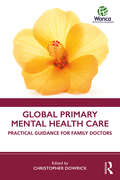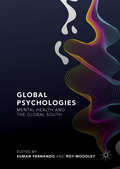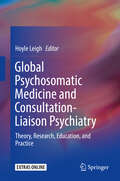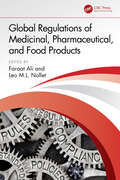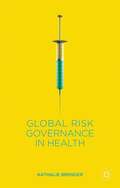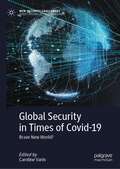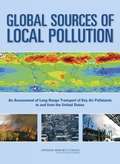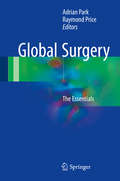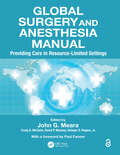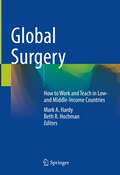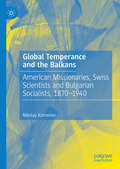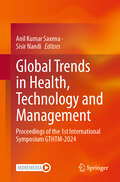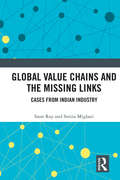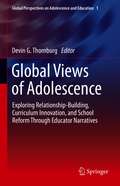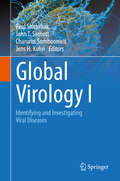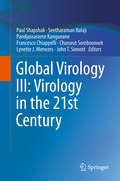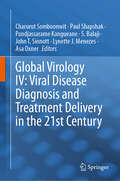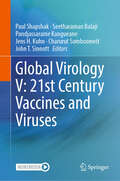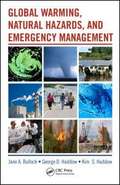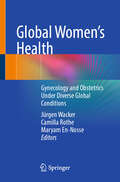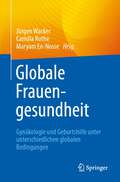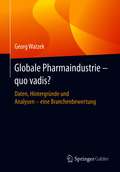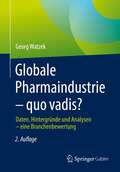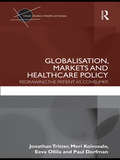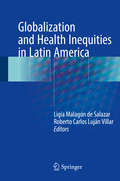- Table View
- List View
Global Primary Mental Health Care: Practical Guidance for Family Doctors (WONCA Family Medicine)
by Christopher DowrickThis book provides up-to-date, practical information for family doctors on how to assess and manage important mental health problems presenting in primary care settings. Patients frequently present with mental health problems in primary care settings around the world, yet family doctors consistently identify gaps in their knowledge, skills and confidence in how best to care for them. Contributors to the book are experts in primary mental health care and have consulted with family doctors around the world, to identify their main learning needs. Each of the nine core chapters will begin with a set of key points on ‘how to do it’ and will end with educational material in the form of clinical scenarios and multiple choice questions. This book describes core competencies for primary mental health care, clarifies how to conduct a first consultation about depression, reviews non-drug interventions for common mental health problems, discusses the management of unexplained physical symptoms, and advises on the physical health care of patients with severe mental illness. It explores the mental health needs of migrants and young people, and explains how to manage problems of frailty, multimorbidity and dementia. This book will be of interest to family doctors and students specialising in family medicine worldwide.
Global Psychologies: Mental Health and the Global South
by Roy Moodley Suman FernandoThis book critiques our reliance on Eurocentric knowledge in the education and training of psychology and psychiatry. Chapters explore the diversity of ‘constructions of the self’ in non-Western cultures, examining traditional psychologies from Africa, Asia, Australasia, and Pre-Columbian America. The authors discuss liberation psychologies and contemporary movements in healing and psychological therapy that draw on both Western and non-Western sources of knowledge. A central theme confronted is the importance, in a rapidly shrinking world, for knowledge systems derived from diverse cultures to be explored and disseminated equally. The authors contend that for this to happen, academia as a whole must lead in promoting cross-national and cross-cultural understanding that is free of colonial misconceptions and prejudices. This unique collection will be of value to all levels of study and practice across psychology and psychiatry and to anyone interested in looking beyond Western definitions and understandings.
Global Psychosomatic Medicine and Consultation-Liaison Psychiatry: Theory, Research, Education, and Practice
by Hoyle LeighThis authoritative reference surveys mind-body healing concepts and psychosomatic medicine in diverse countries and regions of the world. It provides practical insights on the Western division between medical and mental healing and useful information concerning recent efforts to bridge that enduring divide, particularly in the use of ancient and indigenous healing knowledge in psychosomatic practice. Coverage compares and contrasts current applications of psychosomatic medicine and/or consultation-liaison psychiatry as conducted in such representative countries as France, Britain, China, India, Argentina, Canada, and the United States. And the book predicts how this synthesis of traditions and advances will progress as it: Traces the history and development of psychosomatic medicine.Reviews contributions of traditional healing methods to psychosomatic medicine.Analyzes national styles of psychosomatic medicine as practiced in specific countries.Compares the status of psychosomatic medicine / consultation-liaison psychiatry in various countries. Considers the future of psychosomatic medicine as the field, and the world, evolves. Global Psychosomatic Medicine and Consultation-Liaison Psychiatry expands the knowledge base for psychiatrists, primary care physicians, psychiatric and primary care residents, medical students, behavioral medicine specialists, and others who are interested global and regional perspective on providing biopsychosocial care. It is also relevant for advanced students in health psychology and behavioral medicine, and for professionals in related health fields.
Global Regulations of Medicinal, Pharmaceutical, and Food Products
by Leo M.L. Nollet Faraat AliMedicine regulation demands the application of sound medical, scientific, and technical knowledge and skills, and operates within a legal framework. Regulatory functions involve interactions with various stakeholders (e.g., manufacturers, traders, consumers, health professionals, researchers, and governments) whose economic, social, and political motives may differ, making implementation of regulation both politically and technically challenging. This book discusses regulatory landscape globally and the current global regulatory scenario of medicinal products and food products comprehensively.Features: Discusses how recent developments of medicinal and food products have opened up innovative solutions for many of the current challenges societies face presently. Explores the manifold variations between the regulatory bodies in different countries that have not previously been collected to this extent. Presents details on the substantial progress in analytical methodologies for labelling applications and the creation of appropriate test criteria for pharmaceuticals and their safety analysis. Reviews how more worldwide collaboration and cooperation in the regulatory area is still required.
Global Risk Governance In Health
by Nathalie BrenderEpidemics know no borders and are often characterized by a high level of uncertainty, causing major challenges in risk governance. The author shows the emergence of global risk governance processes and the key role that the World Health Organization (WHO) plays within them.
Global Security in Times of Covid-19: Brave New World? (New Security Challenges)
by Caroline VarinWritten in the middle of a pandemic, this book examines the effect of COVID-19 on regional and global security threats in the first 18 months of the crisis. Throughout history, epidemics have disrupted human civilisations, changed the structure of societies, decided the outcome of wars and prompted incredible technological innovation. Despite massive progress in science, institution-building and cooperation over the past 100 years, COVID-19 has revealed the weaknesses of a world under-prepared for a new disease – that had been widely expected and long overdue! This edited volume brings together leading security experts from Africa, Asia, Europe, the Americas and the Middle East to share their analysis of the COVID-19 outbreak and its impact on major security threats, including the rise of terrorists and criminal networks and global power politics. The book highlights important lessons learnt from all corners of the planet, in particular the need for cross-sectional, regional and international cooperation and solidarity when it comes to facing any transnational security threat that does not respect political boundaries.
Global Sources of Local Pollution: An Assessment of Long-Range Transport of Key Air Pollutants to and from the United States
by National Research Council of the National AcademiesRecent advances in air pollution monitoring and modeling capabilities have made it possible to show that air pollution can be transported long distances and that adverse impacts of emitted pollutants cannot be confined to one country or even one continent. Pollutants from traffic, cooking stoves, and factories emitted half a world away can make the air we inhale today more hazardous for our health. The relative importance of this "imported" pollution is likely to increase, as emissions in developing countries grow, and air quality standards in industrial countries are tightened. Global Sources of Local Pollution examines the impact of the long-range transport of four key air pollutants (ozone, particulate matter, mercury, and persistent organic pollutants) on air quality and pollutant deposition in the United States. It also explores the environmental impacts of U.S. emissions on other parts of the world. The book recommends that the United States work with the international community to develop an integrated system for determining pollution sources and impacts and to design effective response strategies. This book will be useful to international, federal, state, and local policy makers responsible for understanding and managing air pollution and its impacts on human health and well-being.
Global Surgery
by Adrian Park Raymond PriceThis text was developed as a book aimed at surgeons and allied health professionals that provides an introduction to the unmet needs , epidemiological, socioeconomic and even political factors that frame Global Surgery. Following upon an understanding of these issues, the text is a practical guide that enables the reader on several levels: to work cross culturally , build relationships and negotiate the logistical challenges of bringing surgical care to low resource settings; to develop an approach to the management of various clinical conditions that would be unfamiliar to most "western" surgeons. Global Surgery is a recently coined term that encompasses many potential meanings. Most would agree that it focuses on the growing recognition of the crisis of access to quality surgical care in low resource settings. Such scenarios exist on every continent. Increasingly surgeons, allied health professionals (NGO), Public Health / Health Policy professionals as well as governmental and non-governmental organizations are engaging in this field. Many surgeons have an interest in Global Health and a desire to become involved but feel ill equipped to do so and unsure where to start. Global Surgery: The Essentials serves as a ready resource to equip surgeons to manage clinical scenarios that lie beyond the scope of their training or current practice but that they would reasonably be expected to encounter in the field.
Global Surgery and Anesthesia Manual: Providing Care in Resource-limited Settings
by John G. Meara Craig D. McClain Selwyn O. Rogers David P. MooneyTo help advance global surgery as a public health intervention, providers and students require a practical, hands-on manual to train them to provide safe and effective surgery and anesthesia in resource-limited settings. This guide provides in-depth instruction on epidemiology and ethics surrounding surgical services, and on anesthesia, non-trauma surgery, and trauma surgery. With contributions from a group of culturally and academically diverse clinicians, each chapter is enriched by at least one commentary from a surgeon or anesthetist in a low- or middle-income country (LMIC) who shares first-hand perspectives on the realities and complexities of providing surgical care in these settings with limited resources.
Global Surgery: How to Work and Teach in Low- and Middle-Income Countries
by Mark A. Hardy Beth R. HochmanFew books have been published to assist local and visiting clinicians in addressing opportunities to expand surgical care in low- and middle-income countries. With contributions from international experts and surgical leaders, this book serves as a valuable resource for local and visiting faculty, trainees, and students in their endeavors to deliver surgical services in existing facilities as well as to develop new infrastructures for specialized surgical care. This book presents an anthology of important lessons gleaned from the experiences of participants in selected academic global surgery centers and existing partnerships all over the world. Contributing authors summarize methods to build partnerships and expand capacity with a focus not only on how to, but also on what worked, what didn’t work, and what could be done differently. They discuss specific examples ranging from implementing colon cancer screening to building a transplant program. In addition, several chapters describe approaches to diagnosis and management of specific surgical pathologies in limited resource environments as a complement to standard surgical texts in general surgery, thoracic surgery, neurosurgery, urology, obstetrics and gynecology, orthopedics, and surgery for contractures and burns. Practical and user-friendly, Global Surgery encapsulates the increasing enthusiasm of young faculty, trainees and medical students to improve access to surgical care in the world’s low- and middle-income countries.
Global Temperance and the Balkans: American Missionaries, Swiss Scientists and Bulgarian Socialists, 1870–1940
by Nikolay KamenovThis book examines the local manifestation of the global temperance movement in the Balkans. It argues that regional histories of social movements in the modern period could not be sufficiently understood in isolation. Moreover, the book argues that broad transformations of social movements – for example, the power centers associated with moral/religious temperance and the later, scientifically based anti-alcohol campaigns – are more easily identifiable through a detailed regional study. For this purpose, the book begins by sketching the historical development as well as the main historiographical themes surrounding the worldwide temperance movement. The book then zooms in on the movement in the Balkans and Bulgaria in particular. American missionaries founded the temperance movement in the closing decades of the nineteenth century. The interwar period, however, witnessed the proliferation of new, professional organizations. The book discusses the various branches as well as their international and political affiliations, showing that the anti-alcohol reform movement was one of the most important social movements in the region.
Global Trends in Health, Technology and Management: Proceedings of the 1st International Symposium GTHTM-2024
by Anil Kumar Saxena Sisir NandiThis book presents the proceedings of the 1st International Symposium on Global Trends in Health, Technology and Management (GTHTM-2024), held on March 15-17, 2024, in Dehradun, India. It reports on recent advances in the interdisciplinary fields of health, technology, and management covering a broad spectrum of topics like drug discovery and development including diseases like cancer, tropical and lifestyle diseases, agroecology, artificial intelligence, and machine learning. The symposium is jointly organised by the Global Health Techno Management Forum and the Global Institute of Pharmaceutical Education and Research, Kashipur, India, together with the Veer Madho Singh Bhandari Uttarakhand Technical University, Dehradun, India. It builds on the success of previous conferences such as the International Symposium on Drug Design and Development Research (DDDR-2021), International Symposium on Current Trends in Pharmaceutical and Medical Sciences (CTPMS-2020), International seminar on Global Trends in Health and Environment (2016), International Seminar on Pharmaceutical Education and Research (ISPER-2010), and the 9th International Symposium on Computational Methods in Toxicology and Pharmacology Integrating Internet Resources (CMTPI-2017). Offering a timely snapshot of cutting-edge, multidisciplinary research and developments in drug design and health sciences, these proceedings facilitate the transfer of these findings to industry and offer a unique perspective on One Health sustainability. As such, the book will appeal not only to students and researchers but also to professionals interested in these fields.
Global Value Chains and the Missing Links: Cases from Indian Industry
by Saon Ray Smita MiglaniGlobal value chains (GVCs) are fraught with the phenomenon of fragmentation and dispersion of production across the world. India presents a unique example with its high potential in manufacturing capability but low integration in GVCs. This book examines the reasons why India has failed to integrate within GVCs so far and looks at key examples to understand the impediments in this process. The chapters bring together case studies from across the manufacturing industry – labour-intensive (garment, paper and diamond), capital-intensive (automobile and petrochemical), and knowledge-intensive (semi-conductor microchip, chemical and pharmaceutical) sectors. Together, they present stories of successful integration of some firms in GVCs as well as the difficulties faced by them. The volume also highlights the importance of GVCs in the context of developing countries in terms of benefits such as income and value generation, knowledge and technology collaborations, and advances in systems and processes. This book will interest scholars and researchers in economics, international trade studies, development economics and business management as well as to practitioners, policymakers, government officials, and those in the corporate sector.
Global Views of Adolescence: Exploring Relationship-Building, Curriculum Innovation, and School Reform Through Educator Narratives (Global Perspectives on Adolescence and Education #1)
by Devin G. ThornburgThis book addresses what teachers and school leaders from a dozen countries see as the social and emotional strengths, interests and needs of adolescents in their schools and communities; how they innovate their programs and practices to respond to their students’ lives. The book also describes how educators themselves benefit from social and emotional supports to be responsive. Rather than assume that there are universal themes in adolescents’ lives, the book is intended to illuminate the local, contextual, and powerful insights of educators daily working with students. In many intentional respects, each serves as an action research study with an effort to better the process and outcomes of their students’ growth and learning as well as to enrich the classroom. The chapters are organized by themes, ranging from challenges adolescents face in that particular locale to curriculum work that is project-based, transdisciplinary, and tied to the communities where the adolescents live. ‘The voices of adolescents, particularly with regard to their social and emotional development have been neglected in the literature. Thus, we know very little about their feelings and personal experiences as they progress through their schooling. A book such as this will be beneficial in terms of providing a contribution to this field, thereby increasing our understanding of the issues faced by adolescents across countries and cultures.’ Peggy L. Anderson, Ph.D., Metropolitan State University of Denver ‘The outstanding strength of this book is quite precisely its international scope: here is an anthology that lives up to the claims made by its title. Anyone interested in either adolescent development or Social and Emotional Learning in real world as opposed to abstract settings will appreciate the breadth of experience described.’ Mokhtar El Maouhal, Laboratoire de Recherche sur les Langues et la Communication
Global Virology I - Identifying and Investigating Viral Diseases
by Jens H. Kuhn Paul Shapshak John T. Sinnott Charurut SomboonwitThis book provides trajectories and illustrations of viruses that have catapulted into the global arena (linked to humans, animals, and vectors) due to human behaviors in recent years, as well as viruses that have already shown expansion among humans, animals, and vectors just a few decades ago. Topics in the current book include: vaccines environmental impact emerging virus transmission Filovirus (Ebola) hemorrhagic fevers flaviviruses Dengue evasion papillomaviruses Hepatitis C Nipah virus giant viruses hantaviruses bunyaviruses encephalitides West Nile virus Zika virus XMRV henipaviruses human respiratory syncytial virus influenza A virus several aspects of HIV-1
Global Virology III: Virology in the 21st Century
by Pandjassarame Kangueane Francesco Chiappelli Paul Shapshak John T. Sinnott Charurut Somboonwit Seetharaman Balaji Lynette J. MenezesGlobal Virology, Volume III: Virology in the 21st Century examines work that has been undertaken, or is planned, in several fields of virology, in an effort to promote current and future work, research, and health. Fields and methods addressed include virology, immunology, space research, astrovirology/astrobiology, plasmids, swarm intelligence, bioinformatics, data-mining, machine learning, neural networks, critical equations, and advances in biohazard biocontainment. Novel and forward-looking methods, techniques, and approaches in research and development are presented by experts in the field.
Global Virology IV: Viral Disease Diagnosis and Treatment Delivery in the 21st Century
by Pandjassarame Kangueane Paul Shapshak John T. Sinnott Charurut Somboonwit S. Balaji Lynette J. Menezes Asa OxnerIn the face of recent viral outbreaks and a global viral pandemic, the necessity for innovation and continued rapid advancement in viral diagnosis and treatment methods has become even more apparent. Global Virology IV: Viral Disease Diagnosis and Treatment Delivery in the 21st Century explores the latest advances in virology and trends in clinical practice, focused on foundational principles and advancements expected to significantly impact this field. Chapters address SARS-CoV-2, Ebola, Zika, Mpox, and Hepatitis C, among other key viral threats, before presenting a detailed analysis of antiviral agents broadly and concerning specific vulnerable populations such as stem cell and solid organ transplant recipients. It is designed as a helpful resource for medical students, scientists, and professionals, bridging current practice and future applications and inspiring further innovations and improvements in global health.
Global Virology V: 21st Century Vaccines and Viruses
by Pandjassarame Kangueane Jens H. Kuhn Paul Shapshak John T. Sinnott Charurut Somboonwit Seetharaman BalajiThe purpose of this fifth volume in the Global Virology series is to describe and propose vaccines, focusing primarily on viral vaccines. In addition to human vaccines, animal viral vaccines are included since animals are used in vaccine research, and the spread of diseases to, from, and among animals, birds, and humans permeates the ecosystem. Due to climatic, geographical, and social factors, there is increased global spread of viruses and other infectious agents. Contributory factors include global warming, spread of vectors, increased human travel, encroachment into animal and avian environments, war, pestilence, malnutrition, and environmental, economic, and social collapse. GVV will address vaccines for many of the viruses addressed in previous series volumes, as well as for viruses not previously covered, and novel and future vaccine technologies. Advances in vaccine effectiveness and molecular engineering approaches are included, such as gene therapy, and CRISPR technologies.
Global Warming, Natural Hazards, And Emergency Management
by George Haddow Jane A. Bullock Kim HaddowScientists predict the earth is facing 40-to-60 years of climate change, even if emissions of carbon dioxide and other global warming gases stopped today. One inevitable consequence of the greenhouse gases already in the atmosphere will be an increase in the frequency and severity of natural disaster events. Global Warming, Natural Hazards, and Emergency Management documents the imperative need for communities to prepare for the coming effects of climate change and provides a series of in-depth, road-tested recommendations on how to reduce risks for communities and businesses. Frontline Advice for Increasing Defenses and Reducing Impacts of Global Warming Authored and edited by emergency management and environmental protection professionals from the Federal Emergency Management Agency (FEMA) and the Sierra Club, this book offers case histories from communities across America that have successfully reduced the extent and consequences of natural disasters. These examples are becoming increasingly important to understand and replicate as the risks to communities created by a changing climate rise. This book recognizes three fundamental principles essential to developing a disaster-prevention strategy: The protection of natural systems is an important security measure The reduction of disaster risk, not just response, is of great importance Local communities must take the lead in prevention efforts Provides Local Governments with Replicable Case Histories of Hazard Mitigation Efforts This no-nonsense reference is a procedural roadmap for emergency managers, policy makers, and community officials. It explains how to develop community partnerships among a myriad of stakeholders; identifies staffing and resource requirements for successful programs; and provides a step-by-step demonstration of the disaster-planning process at the community level.
Global Women's Health: Gynecology and Obstetrics Under Diverse Global Conditions
by Jürgen Wacker Camilla Rothe Maryam En-NosseIn this book, editors and their co-authors discuss medical topics and their diverse circumstances in the global context. They explore where German standards stand in comparison to global conditions, what is important in women's healthcare – and what is less so, which standards are universally applicable, and where meaningful regional variations exist. The book, written in clear and understandable language, is aimed at gynecologists, obstetricians, midwives, and nurses involved in humanitarian aid, as well as anyone interested in the future development of global medicine. Content includes: General medical concepts and worldwide statistics Family planning worldwide Women's health in the face of climate change, population growth, and food shortages Incidence of preeclampsia, management of childbirth, birth injuries, and cesarean section Therapy options for gynecological carcinomas and palliative care Management of normal childbirth in poor and rich countries Female Genital Mutilation (FGM) Tropical diseases and infections related to pregnancy and childbirth Separate guidelines for poorer and richer countries?
Globale Frauengesundheit: Gynäkologie und Geburtshilfe unter unterschiedlichen globalen Bedingungen
by Jürgen Wacker Camilla Rothe Maryam En-NosseIn diesem Buch diskutieren Herausgeber*innen und ihre Mitautor*innen über medizinische Themen in einer globalen Welt und ihren so unterschiedlichen Gegebenheiten. Wo sind deutsche Standards im Vergleich mit globalen Bedingungen einzuordnen. Was ist wichtig in der Versorgung von Frauen – was ist weniger wichtig, welche Standards gelten universell, wo gibt es sinnvolle regionale Varianten? Aus dem Inhalt Allgemeine medizinische Konzepte und weltweite StatistikenFamilienplanung weltweitFrauengesundheit angesichts Klimawandel, Bevölkerungsentwicklung, Nahrungsmangel und globaler PandemienAuftreten von Präeklampsie, Leitung der Geburt, Geburtsverletzungen und KaiserschnittTherapieoptionen von gynäkologischen Karzinomen und Möglichkeiten der Palliativmedizin Weitere Kapitel beschäftigen sich mit der Medizin von Migrantinnen, der Female Genital Mutilation (FGM), Tropenerkrankungen und Infektionen im Zusammenhang mit Schwangerschaft und Geburt. Das in klarer verständlicher Sprache geschriebene Buch richtet sich an Gynäkolog*innen, Geburtshelfer*innen, Hebammen und Pflegende, die in der humanitären Hilfe tätig sind sowie an alle Interessierten, denen die zukünftige Entwicklung der globalen Medizin am Herzen liegt.
Globale Pharmaindustrie - quo vadis?: Daten, Hintergründe und Analysen - eine Branchenbewertung
by Georg WatzekDieses Buch beleuchtet die gegenwärtige Situation der globalen Pharmaindustrie und ihre künftige Entwicklung. Die Pharmaindustrie galt Jahre lang als eine der wirtschaftlich stabilsten und von konjunkturellen Phasen unbeeinträchtigsten Industriezweige. In den letzten Jahren kamen allerdings Zweifel an ihrer Produktivität und ihren Zukunftsaussichten auf. Zur Offenlegung der Ist-Situation und Abschätzung zukünftiger Veränderungen erfolgt in diesem Buch zunächst eine Aufarbeitung der fundamentalen Grundlagen der gesamten Branche samt Analyse erfassbarer Finanzdaten sowie gegenwärtiger und in Zukunft zu erwartender medizinischer und Einfluss nehmender demographischer Entwicklungen. Geprüft werden jeweils die historische Entwicklung, die gegenwärtige Lage sowie auf Basis dieser Daten die zukünftigen Aussichten. Als Unterlagen dienen der quantitative und qualitative Stand der Arzneimittelforschung, Umfang und Inhalt der Forschungspipelines, die Form der Produktvermarktung und des Vertriebs, die Finanzdaten der globalen Top 20 Pharmaunternehmen, medizinische Gesichtspunkte sowie Gestaltung und Problematik der Preispolitik. Einbezogen in die Überlegungen werden auch Auswirkungen eventueller makroökonomischer, legistischer oder politischer Veränderungen.
Globale Pharmaindustrie – quo vadis?: Daten, Hintergründe und Analysen – eine Branchenbewertung
by Georg WatzekDieses Buch beleuchtet die gegenwärtige Situation der globalen Pharmaindustrie und ihre künftige Entwicklung. Die Pharmaindustrie galt Jahre lang als eine der wirtschaftlich stabilsten und von konjunkturellen Phasen unbeeinträchtigsten Industriezweige. In den letzten Jahren kamen allerdings Zweifel an ihrer Produktivität und ihren Zukunftsaussichten auf. Zur Offenlegung der Ist-Situation und Abschätzung zukünftiger Veränderungen erfolgt in diesem Buch zunächst eine Aufarbeitung der fundamentalen Grundlagen der gesamten Branche samt Analyse erfassbarer Finanzdaten sowie gegenwärtiger und in Zukunft zu erwartender medizinischer und Einfluss nehmender demographischer Entwicklungen. Geprüft werden jeweils die historische Entwicklung, die gegenwärtige Lage sowie auf Basis dieser Daten die zukünftigen Aussichten. Als Unterlagen dienen der quantitative und qualitative Stand der Arzneimittelforschung, Umfang und Inhalt der Forschungspipelines, die Form der Produktvermarktung und des Vertriebs, die Finanzdaten der globalen Top 20 Pharmaunternehmen, medizinische Gesichtspunkte sowie Gestaltung und Problematik der Preispolitik. Einbezogen in die Überlegungen werden auch Auswirkungen eventueller makroökonomischer, legistischer oder politischer Veränderungen. Die zweite Auflage wurde aktualisiert und um ein wichtiges Kapitel zu den aktuellen Entwicklungen auf dem Pharma-Markt im Zusammenhang mit der Corona-Pandemie ergänzt - Impfstoffentwicklung, Testkits, Antikörperentwicklung etc.
Globalisation, Markets and Healthcare Policy: Redrawing the Patient as Consumer (Critical Studies in Health and Society)
by Jonathan Tritter Meri Koivusalo Eeva Ollila Paul DorfmanAlthough the last two decades have seen the healthcare systems of most developed countries face pressure for major reform, the impact of this reform on the relationship between empowerment, consumerism and citizen’s rights has received limited research attention. Globalisation, Markets and Healthcare Policy sets out to redress this imbalance. This book explores the extent to which globalisation and commercialisation relate to current and emerging health policies. It also looks at the implications for citizens, patients and social rights, as well as how policy making interacts with the interests of global and European trade and economic policies. Topics discussed include: How the impact of globalisation on health systems is apparent in the influence of international actors and European policies. How the impact of globalisation is mediated by national priorities and policies and is therefore reflected in diverse influences. How commercialisation of health is presented as benefiting citizens and patients but has the potential to undermine the aims and values inherent in health systems. How the role of citizens' interests, social rights, patient’s rights and priorities of patient and public involvement need to be separated from commercialisation, choice and consumerism in health care. Essential reading for policy makers and students of public policy, politics, law and health services, Globalisation, Markets and Healthcare Policy will also appeal to those interested in patient involvement international healthcare, international relations, trans-national organisations and the EU.
Globalization and Health Inequities in Latin America
by Ligia Malagón de Salazar Roberto Carlos Luján VillarThis book critically analyses the influence of international policies and guidelines on the performance of interventions aimed at reducing health inequities in Latin America, with special emphasis on health promotion and health in all policies strategies. While the implementation of these interventions plays a key role in strengthening these countries’ capacity to respond to current and future challenges, the urgency and pressures of cooperation and funding agencies to show results consistent with their own agendas not only hampers this goal, but also makes the territory invisible, hiding the real problems faced by most Latin American countries, diminishing the richness of local knowledge production, and hindering the development of relevant proposals that consider the territory’s conditions and cultural identity. Departing from this general analysis, the authors search for answers to the following questions: Why, despite the importance of the theoretical advances regarding actions to address social and health inequities, haven’t Latin American countries been able to produce the expected results?Why do successful initiatives only take place within the framework of pilot projects?Why does the ideology of health promotion and health in all policies mainly permeate structures of the health sector, but not other sectors?Why are intersectoral actions conjunctural initiatives, which often fail to evolve into permanent practices? Based on an extensive literature review, case studies, personal experiences, and interviews with key informants in the region, Globalization and Health Inequities in Latin America presents a strategy that uses monitoring and evaluation practices for enhancing the capacity of Latin American and other low and middle-income countries to implement sustainable processes to foster inclusiveness, equity, social justice and human rights.
